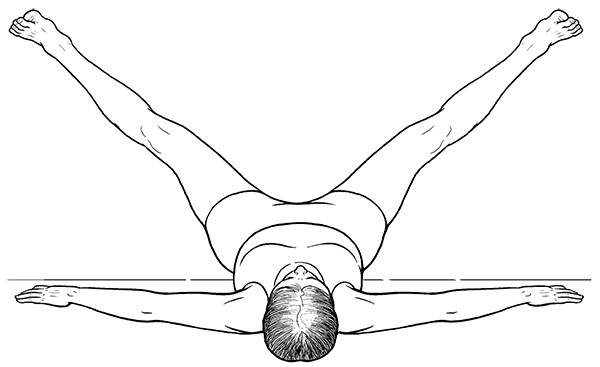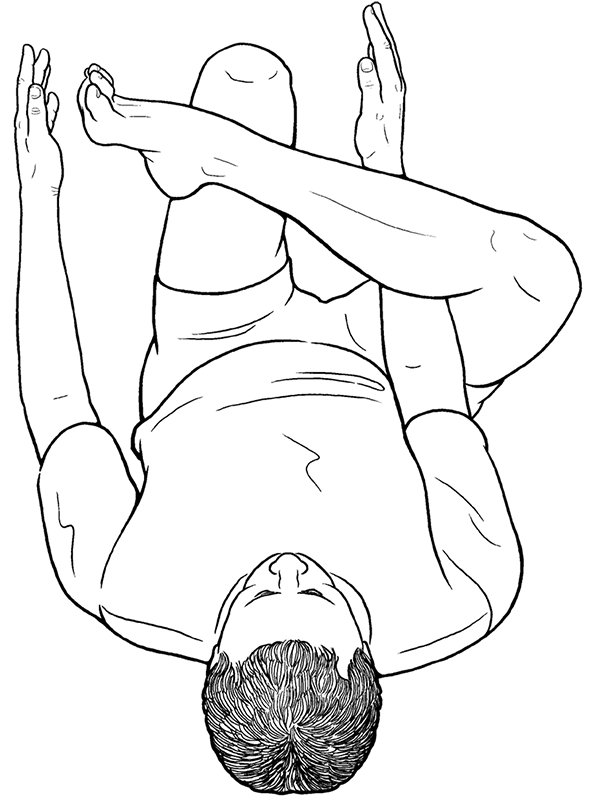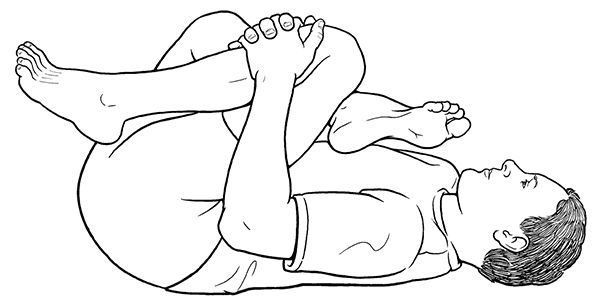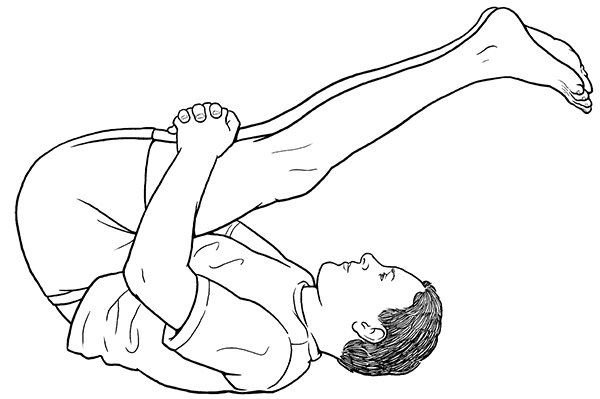Chinese Healing Exercises (10 page)
Read Chinese Healing Exercises Online
Authors: Steven Cardoza
Tags: #Taiji, #Qi Gong, #Daoist yoga, #Chinese Healing, #Health, #medicine, #remedy, #energy

When this becomes easy for you and you are able to be close to having your head touch the ground on the forward bend, or if your find this easy from the start, you can do the more full version of this exercise. Begin seated on the floor as above, with both legs extended, spread as far apart as is comfortable, with the back of the knees very close to the ground without locking them, and feet perpendicular to the ground. Keep your back straight. Place your hands on your legs, below your knees, and as you incline forward as above, slide them down to your feet. Grab your feet and keep them held perpendicular to the ground, not tilted forward or splayed out to the sides. Take a comfortable deep breath in, and while slowly exhaling, lower your torso farther forward, evenly between your legs. Continuing to hold your feet perpendicular to the ground, gently pull on them as you incline your upper body forward. Repeat the breath and increase the stretch on the exhale
(
Fig 2.10
).
When you reach the place beyond which you can stretch no further, hold that stretch for five to ten slow, deep breaths, allowing yourself to relax into that stretch more fully with each exhalation. Then release your feet, place the palms of your hands on the floor in front of you spread slightly wider than shoulder width apart, and use them to push yourself back to an upright seated position, so you won't strain your back. Repeat the stretch once or twice more.
Variation
Some people find either seated version of this stretch too difficult. Rather than pass on this exercise entirely, this variation will be particularly helpful in beginning the stretch, and will in time enable you to do the seated version. Here, lie on your back with your butt against a wall, your legs extended upward, the backs of your knees as close to the wall as you can comfortably get them without locking them. Your arms should be palms down on the floor, either extended straight out to your sides or angled toward the wall, whichever feels best to you. In this position, spread your legs as wide as is possible, still keeping them against the wall for support
(
Fig 2.11
).
That may only be a few inches apart to start with. Breathe, and on each exhalation, be conscious of letting your legs relax more. If they relax enough to spread a little wider, that's great. In this position, gravity is only working on the weight of your legs, which is much less than the weight of your torso, so it won't make you want to stretch more than you're able. When you reach the point at which your legs won't spread any farther, take five to ten slow, deep breaths, allowing yourself to get more relaxed with whatever amount of stretch you have. Then bring your legs back together, roll to one side or the other, and sit or get up. Whenever you're ready, after a few weeks or month of this variation, you may feel ready to begin the seated version of this exercise to increase the benefits it provides.
 Figure 2.11 (Seated Split)
Figure 2.11 (Seated Split)
Note:
While there is no absolute order in which these exercises must be practiced, the order given throughout this book is suggested because it helps to progressively open related body regions. At this point, you may want to practice the
8. Seated Torso Twist
, the eighth exercise given in chapter 6. It can readily prepare the Hip Rotator Stretch, and it is convenient because you are in a seated position on the floor.
6. Hip Rotator Stretch
The hip rotators cross below and deep into the gluteal muscles (hip extensors), attaching on one end to the femur, in the upper thigh. They function both on the legs and the hips, and are included here as this exercise conveniently follows the ones preceding it. It could just as appropriately have been placed in the chapter on hip exercises.
Purpose
Physical:
Opens up the hip rotator muscles, helps stabilize the pelvis and hips, reduces low back and hip pain. The hip rotators attach to the upper thigh bone (the greater trochanter of the femur) on one end, and to the inner and lower border of the upper edge of the back of the hip bone, the ilium of the upper pelvis and ischium and ischial tuberosity of the lower pelvis on the other. Most of the muscles in the low back attach to the upper border of the outer surface of the ilium, while some attach to the sacrum. When either or both sets of muscles are tight, it creates a type of tug of war, with the upper part of the ilium as the center point of the war. That causes hip and pelvis instability, which can lead to various gait problems, and is one significant cause of the lower back pain that plagues so many people.
Energetic:
Opens and activates the lower portion of the Gall Bladder meridian, which runs through the posterio-lateral to lateral (outside) portion of the butt and down the lateral sides of the legs. This meridian facilitates physical, emotional, and energetic balance. The Gall Bladder meridian is called the Leg Shao Yang, or Lesser Yang meridian, and occupies a region of medium depth in the body. In that position, it can harmonize more interior processes (Yin) with more exterior (Yang), as one aspect of energetic balance. Through its paired Yin organ, the Liver, it helps promote the smooth flow of qi, which aids in creating emotional stability. Through its connection with the extra meridian called the Yang Linking meridian, which also runs up the lateral leg following a similar pathway as the Gall Bladder meridian, it helps to stabilize and strengthen the leg. Here we can see how the physical and energetic purposes dovetail nicely and are mutually supportive.
From a different viewpoint, there is a type of very deep bodywork known as Structural Integration, or Rolfing, as it came to be known, since it was developed by a woman named Ida Rolf in the 1920s. Through decades of recorded observation Rolfers empirically found that an emotion commonly stored in the hip rotator is the sense of having “unrealistic expectations of oneself or of others,” and that releasing the hip rotators often helped to similarly release that life perspective.
Techniques Used
Stretching, Daoist Yoga, focused breathing.
Method
Lie on your back with your knees bent and your feet flat on the floor. Cross your right leg over your left, with your lower right leg just above the ankle, resting just above (toward your torso) your left knee. This creates a roughly triangular space between your thighs. Reach through that space with your right hand, and reach around your left leg with your left hand
(
Fig 2.12
).
Interlock your fingers just below your knee. Alternatively, if you can't reach your left leg below the knee, you can interlock your fingers behind your upper left thigh, just above the back of the knee. Before doing anything else, do your best to relax your entire back and shoulders, so that there is no bow in your back and both your low back and shoulders comfortably touch the floor. You may already feel a significant stretch through your right buttocks, where the hip rotators are located.
 Figure 2.12 (Hip Rotator Stretch)
Figure 2.12 (Hip Rotator Stretch)
Your ultimate objective is to be able to pull on your left leg so that your right lower leg rests on your chest. This must be approached very slowly and carefully, and may take many months to accomplish. As with the other stretches, you'll use your breath to gradually increase the stretch. Take a comfortable deep breath in, and while slowly exhaling, gently pull on your left leg, drawing it, and your right lower leg, closer to your body
(
Fig 2.13
on next page
).
Do your best to keep your back relaxed, straight and not bent, with your shoulders remaining on or very close to the floor. Repeat the breath and increase the stretch on the exhale. When you reach the place beyond which you can stretch no further, hold that stretch for five to ten slow, deep breaths, allowing yourself to relax into that stretch more fully with each exhalation. Then switch leg positions and repeat, stretching your left hip rotators. You can repeat this stretch up to two more times per side. Once you can get your leg to touch your chest, hold one stretch for two minutes, and that's enough.
 Figure 2.13 (Hip Rotator Stretch)
Figure 2.13 (Hip Rotator Stretch)
If your hip rotators or low back are very tight, you may not be able to increase the stretch at all in the beginning. In that case, just hold your starting position, and breathe as directed above without trying to increase the stretch.
Do
try to become more relaxed and release whatever tension you may feel, especially focusing on the exhales to best accomplish that. As you are able to increase the relaxation and release, you will find that you can begin to increase the stretch.
7. Back Rock and Roll
The last exercise in this section is not so much for the legs as it is for the whole back. It's included here because being that it is begun sitting on the floor, it's convenient to do this one after or between any of the previous exercises.
Purpose
Physical:
Opens the back, mobilizes each vertebra to decrease vertebral compression and increase vertebral motion, which helps treat some types of back pain and reduces back stiffness. It also massages all the small muscles of the back, including the ones that attach to adjacent vertebrae, so they get more blood, oxygen, and nourishment to improve function and flexibility.
Energetic:
Stimulates the Urinary Bladder meridian, which runs in two parallel lines on either side of the spine down the centerline of the back of your legs. In addition to benefiting the Urinary Bladder itself, there are points along the UB meridian that access the energy of every organ in the body, so the whole body receives energetic benefit. Stimulates the Du meridian (Governing Vessel) which governs the function of all the yang meridians in the body, another way to energetically benefit the whole body. Between the physical and energetic benefits, this can be a very invigorating exercise.
Techniques Used
Primarily, rocking as a type of self-massage. For people who already have experience, the mind can also be used to increase the daoyin aspect of inducing and guiding qi through the UB and Du meridians.
 Figure 2.14 (Back Rock and Roll)
Figure 2.14 (Back Rock and Roll)